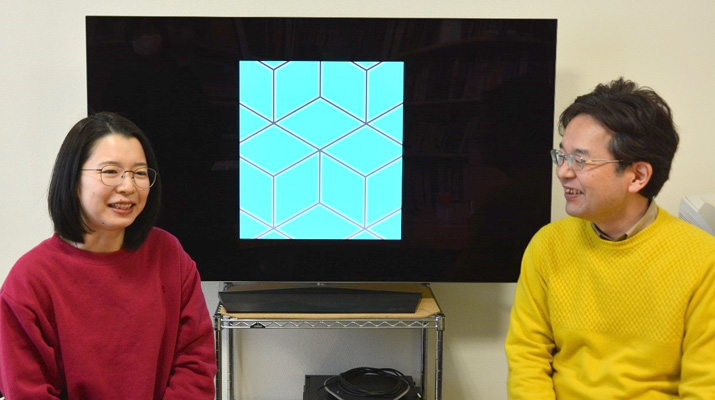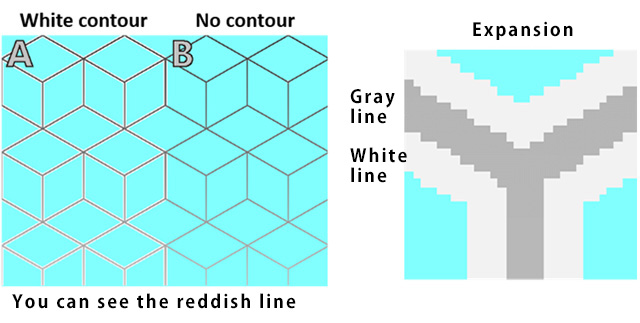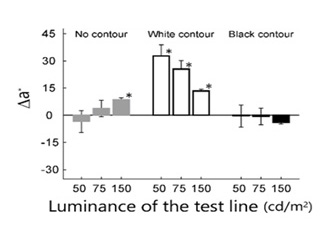
ここからコンテンツです。

White contours induce red hue
A new color illusion that resolves a century-old contradiction relating to simultaneous color contrast By Kowa Koida
A color illusion that strongly induces color contrast effect has been discovered by a research team of the Department of Computer Science and Engineering, and Electronics-Inspired Interdisciplinary Research Institute (EEIRIS) at the Toyohashi University of Technology. The powerful visual illusion clarified a century-old contradiction relating to simultaneous contrast theory. Through a human psychological experiment, the team demonstrated that the presence or absence of flanking contours formed from extremely thin white lines could be used to switch between contradictory visual phenomena, enabling consistent explanation for both discrepant theories. This solution alters theories of visual computation relating to color appearance, and is expected to contribute to industrial design and high-definition imaging.
Under certain circumstances, colors and shapes of physically identical objects will appear to be different. This is known as a visual illusion. “Visual illusions dealing with colors” have long been documented. In the 19th century, a French chemist Michel-Eugène Chevreul has explained that the cause of a complaint relating to textile dyes was not due to chemical reactions but to the visual illusion. These types of optical illusions may have a strong impact on the appearance of a product, with designers having avoided them through trial and error.
However, researchers believe that visual illusions are not a failure of human visual function, but they occur as an “accompanying side effect of intrinsically important functions”. Some novel functions that allow us to see the outside world effectively are often responsible for producing a variety of visual illusions. Thus, discovering new visual illusions is a clue to discover an unknown visual function, and many vision researchers are engaged in such projects.
Among visual illusions color appearance, the most famous one is “simultaneous color contrast”. Simultaneous color contrast is a phenomenon in which color appearance of gray lines changes depending on the background color, based on the opposite color of the background color. Simultaneous color contrast is considered to be an important factor in color constancy, which compensates color appearances of certain objects under various colored illuminations.
While it is known that the effects of simultaneous color contrast vary depending on the luminance of the gray lines being affected, there are “two discrepant theories” about what level of luminance results produce the strongest simultaneous color contrast. “Kirschmann’s Third Law” says that the effect is strongest when the luminance is the same as that of the background, and the “Helson-Judd Effect” says that the darker it gets, the stronger the effect. These phenomena have been verified in the separate fields of psychology and lighting technology, respectively.

Upon discovering a new color illusion, the research team realized the potential to reconcile the above contradiction. In the discovered visual illusion, a phenomenon occurs in which a thin gray line atop a cyan background appears red when bordered by a thin white line. The illusion is gaining attention, and was applied for the World Illusion Contest, winning a place as a Top 10 Finalist in the “Best Illusion of the Year 2018”.
Through human psychological experiment, it was demonstrated that a strong color contrast was produced regardless of the luminance of the gray line, and that the visual illusion effects became stronger the darker the color was comparatively. This result is concordant with the Helson-Judd Effect. On the other hand, with the white line removed, the visual illusion is strongest with identical luminance, reproducing Kirschmann’s Third Law.
In other words, the presence or absence of the flanking white line makes it possible to switch between the two contradictory phenomena. A consistent explanation becomes possible by assuming that the adjacent white line created a separate phenomenon in the gray line known as color assimilation. In conclusion, the team succeeded in resolving a contradiction that has existed among visual illusion researchers for some 100 years.

"This new color illusion produced extremely strong illusory effects regardless of the luminance of the gray line," says lead author Tama Kanematsu (second year doctoral student in the Department of Computer Science and Engineering and DC2 research fellow at the Japan Society for the Promotion of Science).
"This contradicts accepted color illusion research dating back to 1891. By incorporating additional knowledge about color constancy into the illusion, I believe we succeeded in illuminating the true nature of simultaneous contrast in the visual system. Moreover, our newly devised color appearance model allows for a consistent explanation that includes past research," explains Kanematsu.
Lead author Tama Kanematsu says the visual illusion was found accidentally. "Associate Professor Koida reported seeing purple (which he had not been using) when creating a diagram using light blue and blue lines. He first thought it was an optical phenomenon known as chromatic aberration. Upon precisely analyzing the characteristics of the area which appeared purple, we were able to prove that it was a new illusion. In addition, it is clear that this illusion requires an extremely thin line. Without an extremely detailed modern high-performance monitor, it may not have been discovered. This illusion showcased an instance in which a development in engineering contributed to the further development of basic science."
The research team believes it will be necessary to construct a computational model of the illusion that reproduces the color phenomenon. The visual illusions help to understand theoretical framework of visual neurons in the brain. This model is expected to help in improving user impressions of high-definition digital device screen designs, and in industrial design fields such as textiles.
This study was supported by the Ministry of Education, Culture, Sports, Science, and Technology (MEXT) of Japan under 15H05917, 20H00614, 20K12022, 19K22881, and 20J12600.
Reference
Tama Kanematsu and Kowa Koida (2020). Large enhancement of simultaneous color contrast by white flanking contours. Scientific Reports, 10(1):20136. doi: 10.1038/s41598-020-77241-5
白色線で縁取ると赤色になる
同時色対比に関わる100年間の矛盾を解明した新しい色錯視By 鯉田 孝和
豊橋技術科学大学 情報・知能工学系とエレクトロニクス先端融合研究所の研究チームは、新しく発見した色錯視を通じて100年間にわたる同時色対比の理論の矛盾を解明しました。人を対象とした心理実験により一見矛盾する現象が白色線の縁取りの有無によって切り替え可能であることを明らかにし、一貫した説明を可能にしました。この解明によって色の見えに関わる視覚計算理論は改正され、高精細な画像表現や産業デザインに貢献することが期待されます。
ヒトは外界を正しく見ているように思えますが、実際には同じ形や色が違うものに見えてしまうことがあります。これを錯視と言います。色に関する錯視は古くから知られており、19世紀には織物の染色に起こったクレームの原因が色錯視にあったことをフランスの化学者が解明しています。このように錯視は製品の外観に強く影響することがあり、デザイナーらは経験的に錯視を回避していました。一方で、錯視はヒトの視覚機能の失敗ではなく、本来の重要な機能の副作用として生じているという考えがあります。つまり多少錯視が生じるとしても、外界を効率的に見るための機能がその背景にあることが多いのです。新しい錯視を発見することは視覚機能の未知な機能を新たに発見すること同義であり、多くの視覚研究者が研究に取り組んでいます。
色が変わって見える錯視で最も有名なものが同時色対比です。同時色対比とは同じ灰色の線を見ても背景の色によって見えが変わってしまう現象で、背景の色と逆の色に色づきます。同時色対比は照明の色を補正する色恒常性の重要な要素と考えられています。同時色対比は影響を受ける灰色線の明るさによって効果が変わることが知られていますが、どの明るさで変化が強く生じるかは二つの互いに矛盾する理論が知られています。それは、背景と等明るさで最も強く生じるというキルシュマンの第三法則と、暗いほど強く生じるというヘルソン・ジャッド効果です。これらは心理学と照明工学という異なる研究分野でそれぞれ確認されている現象でした。
ここで私たちは色に関する新しい錯視を発見し、この錯視を通じて上記の矛盾を解決できる可能性に気づきました。発見した錯視はシアン色背景上の非常に細い灰色線が白色の細い線で縁取られると赤色に見えるという現象です。この錯視は、世界錯視コンテストに応募してBest Illusion of the Year 2018でTop10 Finalistに入賞し、注目されてきました。人を対象とした精密な心理実験によって、錯視は灰色線の明るさによらず強い色対比が生じ、相対的に暗いほど錯視効果が強くなることを明らかにしました。これはヘルソン・ジャッド効果に相当します。一方で白色線を外すと錯視効果は等輝度で強く、キルシュマンの法則を再現していました。つまり二つの矛盾する現象は白色線の有無によって切り替え可能だったのです。隣接する白色線は色同化という異なる現象を灰色線に誘導していたと考えることで一貫した説明が可能となりました。以上により、およそ100年間に渡る色錯視研究に存在していた矛盾を解明することに成功しました。
「この新しい色錯視は、灰色線がどのような明るさであっても非常に強い錯視効果を発生しました。これは、これまで通説とされてきた1891年の色錯視研究と反しています。私たちは色恒常性と呼ばれる別の知見を本錯視に導入することによって、視覚系に備わる同時色対比の真の性質を引き出すことに成功したと考えています。さらに、私たちが新たに考案したモデルによって過去の研究を含めた一貫した説明が可能になります。」と筆頭著者である兼松圭は説明します。
筆頭著者である兼松圭(博士後期課程2年)はこの錯視を発見したのは本当に偶然だったと言います。「鯉田准教授が別の実験データの図を水色と青色の線で描いたときに、使っていないはずの紫色が見えると言いました。鯉田准教授は当初、色収差という光学現象だと思い込んでいたそうです。私は紫色に見える部分の特徴を精密に分析し、新しい錯視であることを証明しました。またこの錯視は非常に細い線が必要であることもわかっています。現代の非常に細かくて高性能なモニターがなければ発見することは出来なかったかもしれません。この錯視を通じて、工学の発展が基礎科学のさらなる発展に寄与した瞬間に立ち会うことが出来ました。」
研究チームは、色錯視の現象を示すこの錯視の計算モデルを組み立てる必要があると考えています。錯視の発生には視覚神経細胞の計算が関与しており、錯視を説明する細胞ネットワークを検討することは脳機能の理解に繋がるとともに、テキスタイルなどの産業デザインや、高精細化されるデジタル機器の画面デザインにおいてユーザーが受け取る印象を推定するのに役立つと考えています。
本研究は文部科学省 科研費 新学術領域研究「多元質感知」(15H05917)、基盤研究 A(20H00614)、基盤研究 C(20K12022)、挑戦的研究(19K22881)及び特別研究員奨励費(20J12600)の助成を受けて実施されました。
Researcher Profile

| Name | Kowa Koida |
|---|---|
| Affiliation | Electronics-Inspired Interdisciplinary Research Institute (EIIRIS) |
| Title | Associate Professor |
| Fields of Research | Neuroscience |
ここでコンテンツ終わりです。
